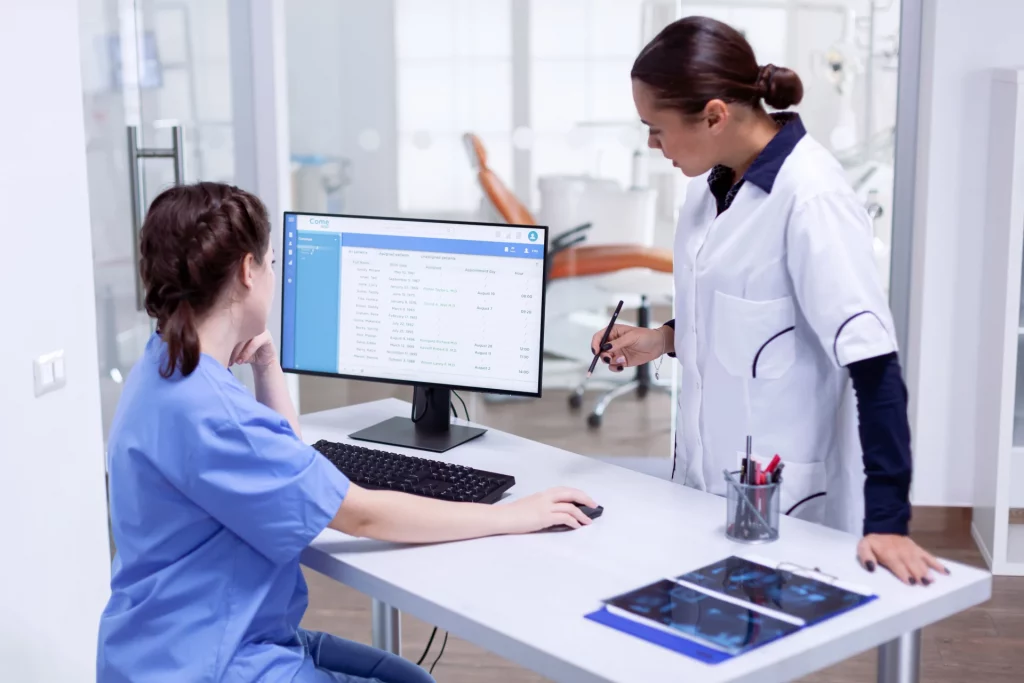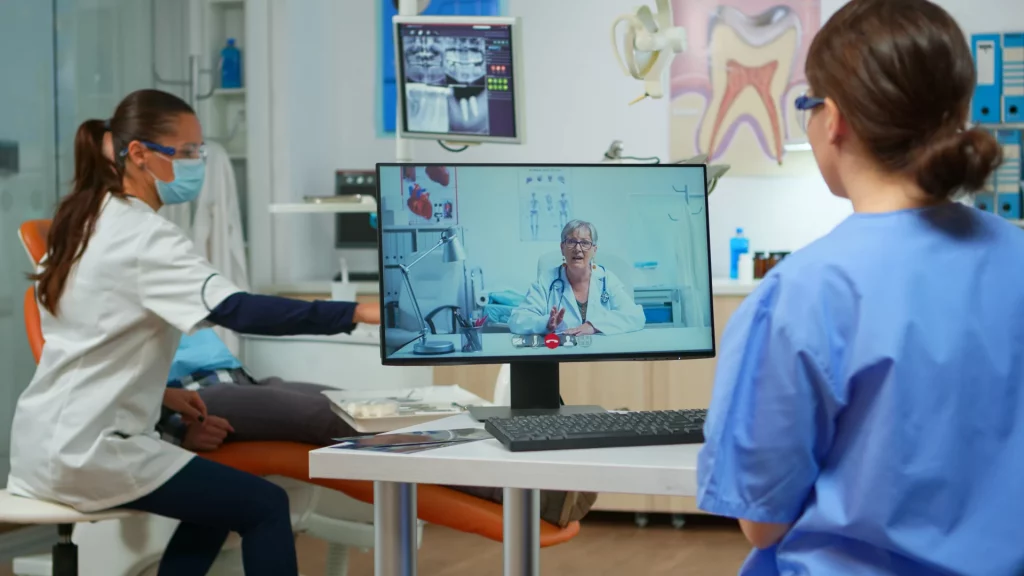Table of Contents
In today’s technology-driven and health-conscious world, digital software solutions are providing a new, modern approach to healthcare that we haven’t seen before.
With the pandemic introducing a new need for remote solutions, the growing healthcare software industry has given both providers and patients the opportunity to explore a modern approach to care—one that prioritizes patient well-being, operational efficiency, and reliable access regardless of location.
Today, 93% of physicians believe digital health tools are an advantage for patient care. As a result, physicians are adopting digital tools more than ever before, with improved clinical outcomes and work efficiency being the key drivers.
The growth of eHealth solutions can be seen around the world, with the global healthcare IT market expected to expand at a compound annual growth rate (CAGR) of 15.8% from 2024 to 2030.
Keep reading to explore the key verticals of healthcare software development, important considerations, emerging trends, and more.
What is Healthcare Software Development?
Healthcare software development is the process of designing and developing software applications tailored for the healthcare industry. It involves various solutions and tools for healthcare professionals, patients, laboratories, and other healthcare organizations to streamline processes and improve patient outcomes. Medical software includes health information technology, telehealth apps, telemedicine apps, electronic medical records, applications that use big data and AI, and much more.
Key Verticals of Healthcare Software Development
Healthcare software development has many sub-categories that meet the needs of different healthcare requirements. To get an idea of how software is used in the healthcare sector, let’s take a look at some of the common applications.
Electronic Health Records (EHR) and Electronic Medical Records (EMR) Software
- Purpose: Stores, manages, and accesses patient medical histories, treatment plans, medication lists, and other health information. EHR software development provides valuable information, allowing providers to manage care more efficiently.
- Users: Healthcare providers, hospitals, clinics.
- Features: Patient portal, care tracking, test results, electronic prescriptions, billing, patient history recording, decision support, lab integration, order entry, appointments.
- Example: Medical Records Tracker – Allows users to securely store and organize health records, medication schedules, and medical appointments.
Telemedicine and Telehealth Software
- Purpose: Provides remote clinical services, consultations, and medical care through digital communication technologies. Telemedicine software development allows for real-time collaboration, helping patients connect with healthcare providers no matter where they’re located.
- Users: Patients, doctors, therapists, remote healthcare providers.
- Features: Virtual consultations, secure messaging, electronic health records, teleradiology solutions, appointment scheduling, telemonitoring integration, health data tracking, medication reminders.
- Example: ECS Clinical – Through telehealth app development, Scopic created a chat application that provides secure and affordable cloud-based communication, consultation, and collaboration.
Medical Practice Management Software
- Purpose: Handles the day-to-day operations of a medical practice, including scheduling, billing, and other administrative tasks. Streamlines tasks and improves workflow productivity.
- Users: Healthcare administrators, medical practices, billing companies.
- Features: Patient management, reporting and analytics, appointment scheduling, billing and invoicing, patient portal, inventory management, electronic health records, automated tasks.
- Example: Medical Case Management System – A web app that centralizes aspects of patient care such as scheduling, charting, treatment planning, and medical billing.
These systems cater to a wide range of healthcare needs and contribute to an efficient workflow for both administration and patient care. One key tool in enhancing productivity is medical software for practices, which streamlines administrative tasks such as scheduling, billing, and maintaining records. Utilizing such software can lead to better practice management by integrating various aspects of daily operations into a cohesive framework.
Pharmacy Management Software
- Purpose: Manages the dispensing of medications, handling of prescriptions, inventory management, and billing in pharmacies. This system helps automate the workflow in a pharmacy, providing quality care to patients.
- Users: Pharmacists, pharmacy technicians.
- Features: Inventory management, electronic prescriptions, prescription management, analytics, expiry control, medication documentation, drug interaction alerts.
- Example: RXWeb – A web-based platform that manages all areas of a pharmacy, including stock ordering and management, clinical services, and patient communications.
Medical Imaging Software
- Purpose: Manages and processes medical images such as X-rays, MRIs, and CT scans. Medical imaging software development also aids in diagnosis, allowing radiologists to monitor the progress of a disease.
- Users: Radiologists, medical imaging technicians.
- Features: Radiology software often has image acquisition and archiving, DICOM support, image analysis, reporting tools, integration with RIS and EHR, and teleradiology capabilities.
- Example: FastPacs DICOM – Radiology information system that allows medical professionals to archive, view, and edit DICOM images.
Radconnect – Image sharing solution that allows images to be shared securely to get a second opinion without having to leave home.
Dental Software
- Purpose: Digitizes dental records and streamlines different aspects of dental operations. Helps dentists oversee their daily business operations.
- Users: Dentists, dental assistants, patients.
- Features: Scheduling, patient registration, billing and insurance, dental charting, appointment reminders, reporting and analytics, treatment planning.
- Example: Shadewave – Enables dentists and labs to determine dental shades more accurately, allowing dental practices to communicate with labs in real-time.
Patient Engagement Software
- Purpose: Engages patients in their healthcare process through appointment scheduling, reminders, health education, and communication tools. Facilitates communication between health care providers and patients, improving patient outcomes.
- Users: Patients, healthcare providers.
- Features: Appointment reminders, patient portal, bill payments, health record viewing, automated messaging, educational resources, health monitoring.
- Example: Wellness Network – Helps users manage their diet and exercise so that they can better manage chronic health conditions.
mHealth (Mobile Health) Applications
- Purpose: Delivers healthcare services and information through mobile devices like smartphones and tablets. mHealth apps monitor users’ health conditions, such as chronic disease, weight, sleep, blood pressure, and mental health.
- Users: Patients, general public, healthcare providers.
- Features: Health tracking, symptom checker, appointment scheduling, payment integration, wearable integration, medicine reminders, remote medical assistance, user education.
- Example: MySelfPlan – Provides daily plans for students to improve their psychological health through interactive features and alerts to reduce stress.
FitStation – A supportive fitness network that allows fitness leaders to provide remote support, with features like workout sending and tracking, goal setting, event scheduling, and more.
Health Information Exchange (HIE) Software
- Purpose: Facilitates the sharing of health information across different healthcare systems and settings. This improves the speed, quality, safety, and cost of patient care.
- Users: Healthcare providers, health information exchanges, regulatory bodies.
- Features: Data exchange, security and privacy controls, consent management, clinical decision support, audit and reporting, integration with health information systems.
- Example: Nautilus – Medical image exchange solution where medical images, reports, and EMR can be exchanged automatically.
Personal Health Record (PHR) Software
- Purpose: Enables patients to maintain and manage their own health information in a centralized location. This helps patients better manage their care and improve health outcomes.
- Users: Patients, caregivers.
- Features: Health information management, medication tracking, lab results management, accessibility across devices, integration capabilities.
- Example: MedicLog – Helps patients record their basic health records and vital signs and share them quickly with their doctors.
Healthcare Analytics and Data Management Software
- Purpose: Analyzes large volumes of healthcare data for insights into patient care, operational efficiencies, and research. This system works to find trends, draw conclusions, and identify the potential for improvement.
- Users: Healthcare analysts, researchers, administrators.
- Features: Predictive analytics, real-time monitoring, data integration, clinical decision support, care coordination, data collection and management.
- Example: Covid by Numbers – Resource with free, up-to-date coronavirus statistics that helps users understand global coronavirus cases, fatalities, excess deaths, and testing rates by country.
IoT Healthcare Applications
- Purpose: Collects and analyzes data from connected healthcare devices and sensors for monitoring and diagnostic purposes. Allows for remote patient monitoring, real-time health data collection, tailored treatment plans, and more.
- Users: Patients, doctors, caregivers.
- Features: Data analytics and insights, integration with wearable devices, telehealth capabilities, and real-time data collection.
- Example: Glucose Buddy – Tracks blood sugar over time with weekly reports and action plans to keep your glucose in check.
Medical Research and Clinical Trials Software
- Purpose: Assists in the research, planning, management, and tracking of clinical study data. Improves data collection and analysis and ensures regulatory compliance.
- Users: Researchers, healthcare providers, regulatory authorities, study participants.
- Features: Electronic data capture, electronic clinical outcome assessment, patient management, real-time monitoring and reporting, regulatory compliance assistance.
- Example: Encapsia – Allows you to manage, explore, visualize, and analyze clinical data effectively.

How to Approach Healthcare Software Development? End-to-end Process
Custom healthcare software development allows companies to provide tailored solutions to healthcare providers and their patients. Developing software in the healthcare sector comes with both challenges and opportunities, making it essential to choose the right healthcare software development company and follow a well-defined development process.
Here’s a quick overview of what to expect from healthcare software product development:
- Step 1 – Define the Problem & Gather Requirements: Your development partner will begin the project by identifying your goals, gathering detailed requirements, and clearly defining the problem the software solution is designed to address. This sets the foundation for the entire project.
- Step 2 – Conduct Technical Research & Plan Specifications: With a clear understanding of the problem, your development partner will then conduct in-depth technical research to explore the most suitable technologies, tools, and system architecture, defining a robust tech stack. This step also includes outlining key software specifications, user flows, and technical requirements—ensuring that every component aligns with your project’s goals and constraints before development begins.
- Step 3 – Design the User Experience (UX/UI): From user research to experience mapping and prototyping, a successful healthcare software design engages users and meets the specific needs of its target audience. This is especially important in healthcare, as it helps healthcare professionals create better care experiences for their patients, thereby improving the success of the software.
- Step 4 – Design the Compliance & Security Framework: Compliance is a crucial aspect of healthcare software and must be applied throughout the entire development process. At this stage, your development partner will design a comprehensive framework that addresses key compliance standards such as HIPAA, GDPR, and other applicable regulations. This step also includes implementing security protocols like data encryption and access controls to safeguard sensitive patient information and maintain system integrity.
- Step 5 – Develop and Integrate Key Systems: The next step of healthcare IT development is to build the core functionalities of the software, which involves writing clean, scalable code and integrating essential systems like EHRs, billing platforms, third-party APIs, and diagnostic tools.
- Step 6 – Test Rigorously: Developers will then perform various tests to ensure the software is functional, secure, and meets user requirements. This step helps identify potential issues before it’s released to users.
- Step 7 – Launch, Monitor & Update: Once your healthcare product passes the above tests, it will be ready for launch. Developers will monitor its performance, using feedback and data to make updates and enhance functionality.
Key Considerations & Challenges in Healthcare Software Development
When it comes to healthcare software development, understanding the key considerations and challenges is essential to creating secure, compliant, and effective digital solutions.
Healthcare Regulatory Frameworks & Their Impact
Some of the key healthcare regulations that developers must consider include:
HIPAA
The Health Insurance Portability and Accountability Act (HIPAA) is a federal law that requires the creation of national standards to protect sensitive patient health information from being disclosed. HIPAA compliance for healthcare software development is especially important in today’s increasingly digital healthcare environment, meaning businesses must prioritize compliance to build trust, avoid legal fees, and uphold the integrity of their business.
There are multiple rules that make up HIPAA. The Privacy Rule establishes national standards to protect patients’ medical records; the Security Rule requires physicians to protect patients electronically stored health information (known as ePHI); and the Breach Notification Rule requires providers to report healthcare data breaches.
HITECH
The Health Information Technology for Economic and Clinical Health Act, or HITECH Act, incentivizes the meaningful use of EHRs and strengthens the privacy and security provisions of HIPAA. Before the HITECH Act was introduced, only 10% of hospitals had adopted EHRs; in other words, many healthcare providers would still be using paper records if this act hadn’t been passed.
By offering financial incentives and enforcing stricter data protection rules, the HITECH Act accelerated the nationwide shift to digital health records and improved the overall quality and coordination of care.
GDPR (for global applications)
General Data Protection Regulation (GDPR) is a strict data protection law passed by the European Union. It applies to all organizations, including healthcare providers, hospitals, clinics, and health insurance companies that process personal data of individuals residing in the EU, regardless of where the processing takes place. This regulation grants data subject rights to individuals, which include the right of access, the right to rectification, the right to erasure, the right to strict processing, the right to data portability, and the right to object.
It also has various data protection principles relevant to healthcare, including security and confidentiality, protection against data breaches, data retention, and purpose limitation.
PIPEDA (Canada)
There are various regulations in other key markets. This includes the Personal Information Protection and Electronic Documents Act (PIPEDA), a law in Canada that governs how private sector organizations collect, use, and disclose personal information.
There are 10 fair information principles that businesses must follow to protect personal information, including:
- Accountability
- Identifying purposes
- Consent
- Limiting collection
- Limiting use, disclosure, and retention
- Accuracy
- Safeguards
- Openness
- Individual access
- Challenging compliance
Important note: Every country has variations in its international healthcare data protection and privacy laws. Key differences may include legal frameworks, specific provisions, and enforcement mechanisms. However, they often have key commonalities, such as the protection of patient data, patient rights, and compliance obligations.
Interoperability and Data Exchange Standards
To ensure success in software development, different programs must be capable of exchanging information, sharing files, and using the same protocols. Here are some of the standards in the healthcare industry:
- Health Level Seven International (HL7): HL7 is a range of global standards for the transfer of clinical and administrative health data between applications. It is considered one of the most successful medical standards and includes test result reporting, order entry of many kinds, and more.
- Fast Healthcare Interoperability Resources (FHIR): FHIR is a HL7 standard that combines the best features of previous standards into a common specification that offers more flexibility, aiding in rapid adoption.
- Standards for electronic data exchange in healthcare: Aside from HL7 and FHIR, some key standards include DICOM, SNOMED CT, and CCDA. These standards exist for communication between medical devices and between devices and EMRs, digital imaging communications, administrative data exchange, and clinical data exchange.
Clinical Accuracy & Risk Mitigation
Due to strict regulations, developers must consider the following during development:
- Design and development considerations: The architecture of a healthcare application must consider the specific regulations in the healthcare industry, which may include quality standards, risk management, documentation and reporting, interoperability, and data exchange, among others.
- Data encryption and security measures: Data encryption is a fundamental component of security in healthcare software product development, as it mitigates the risk of data breaches. By implementing encryption methods, healthcare organizations comply with regulations, protect patient data, and enable secure data sharing.
- User access controls and audit trails: Developers must implement HIPAA-compliant audit trails and audit logs to record and monitor access to electronic protected health information. The system should log details like the date and time of access, the source of access, the identity of the person accessing the information, and the type of action performed.
- Incorporating consent management and patient rights into software: Healthcare providers must obtain valid consent from patients and maintain records of when this consent was given. Preference management programs simplify the collection and management of authoritative user choices, allowing patients to choose how they would like to get in touch and how much communication they would like to receive.
Scalability and Performance
A key aspect of software development for healthcare is scalability.
Businesses that prioritize scalable software solutions are better equipped to handle a growing number of users, customers, and requests—an essential capability for both large medical centers and small healthcare practices.
Some of the ways to ensure scalability and performance include:
- Modular architecture: Building the system in independent, interchangeable modules makes it easier to scale specific components without overhauling the entire application.
- Cloud-based infrastructure: Leveraging cloud services allows the software to dynamically scale resources up or down based on demand.
- Load balancing: Distributing workloads across multiple servers helps maintain performance and reliability during high-traffic periods.
- Regular performance testing: Stress testing and monitoring help identify bottlenecks before they become critical issues, ensuring the software remains robust as usage grows.

Benefits of Reliable Healthcare Software Development
Custom software development for healthcare offers healthcare providers and patients an array of benefits, including:
Improved Patient Outcomes
Since custom software is tailored to the unique needs of its target audience, it offers personalized features and functionality that off-the-shelf solutions can’t match.
For instance, advanced custom solutions can include automated appointment reminders, remote monitoring capabilities, collaboration tools, and more—enhancing both provider efficiency and patient experience.
Enhanced Data Security and Compliance
When you work with software developers that have experience in your field, you can ensure your healthcare solution meets industry-specific regulations, such as the ones mentioned above. By building security into the system framework, your healthcare system protects sensitive patient data, reduces the risk of breaches, and maintains compliance from the ground up.
Streamlined Operations and Workflow Automation
From centralizing patient data to automating time-consuming tasks and improving collaboration, small and large healthcare organizations can agree that streamlined operations are a huge advantage of healthcare software development.
This is also beneficial for patients, as they can enjoy faster service, easier access to their health records, improved communication with providers, and a more personalized care experience.
Cost Savings for Providers and Patients
By automating tasks and increasing productivity, custom software helps organizations reduce administrative overhead, minimize manual errors, and optimize resource allocation—leading to significant cost savings.
With the rise of telehealth applications, patients can also save time and money by avoiding unnecessary travel and reducing in-person visits.
Scalability and Long-Term Adaptability
As your business grows, your software scales with it. This means your solution can adapt to increasing patient volumes and service requests without compromising security or the quality of care.
This is a major advantage for both large organizations and startups alike, as custom software is built to support future growth without disrupting existing operations.
Emerging Trends in Healthcare Software Development
Integrating emerging development technologies helps developers create software with more capabilities and customizable solutions. Emerging trends in this industry include:
AI-Powered Features & Integrations
AI is transforming healthcare with predictive analytics, chatbots, and diagnostic support. With the rise of conversational AI in healthcare, providers can offer more intuitive, responsive, and accessible digital experiences to patients.
AI in radiology is a great example of this, as it interprets and analyzes medical images and automates workflows. AI can also be leveraged for building AI assistants, ChatGPT integration, and structuring unstructured patient data, among others.
Blockchain & Big Data for Secure Medical Records
Combining blockchain with big data ensures tamper-proof medical records and smarter data analysis—boosting both security and efficiency in managing sensitive patient information.
Big data analytics plays a crucial role in this ecosystem by processing large datasets to guide clinical decisions, enable predictive analytics, support population health management, and detect healthcare fraud, ultimately leading to improved patient outcomes.
IoT and Remote Monitoring Devices
The Internet of Things (IoT), a network of interconnected devices that exchange data, is also on the rise. This allows for remote patient monitoring, virtual care, chronic disease management, and wearable technology.
By integrating IoT into custom platforms, healthcare providers can support faster interventions and improve patient outcomes.
Voice Search and Multilingual Accessibility
Voice-enabled interfaces and multilingual support make healthcare services more inclusive. These features improve access for non-native speakers, seniors, and those with disabilities.
For example, a voice-activated patient portal that supports multiple languages can help elderly patients book appointments or access test results without needing to navigate complex menus or type on a keyboard.
Virtual & Augmented Reality
VR and AR are revolutionizing training, diagnosis, and therapy. As generative AI in healthcare continues to evolve, combining these technologies offers new possibilities in simulation and personalized care experiences.
For instance, VR-powered surgical training platforms can simulate complex procedures tailored to a trainee’s skill level.
“As co-founder and COO of Medicai, I led the build-out of a custom, cloud-native medical-imaging platform that unifies PACS, AI triage, and collaborative case management in one interface. We tailored it for mid-size hospitals and specialty clinics that lacked the budget–or patience–for traditional enterprise PACS and the tangle of VPNs, CDs, and couriered films that still dominate day-to-day radiology.
Why we had to build instead of buy?
- Data silos: Radiologists, surgeons, and referring physicians worked in separate systems; image exchange often meant burning CDs or emailing JPEG screenshots.
- Slow turnaround: Critical studies could sit 24-48 hours before a sub-specialist even saw them, stretching length-of-stay and delaying treatment decisions.
- Compliance exposure: Ad-hoc transfers and consumer file-sharing apps made GDPR/HIPAA audits a nightmare. Off-the-shelf PACS vendors offered partial fixes but couldn’t overlay AI routing, tele-consult features, or granular audit trails without hefty customization fees.
What the custom platform delivers?
- One-click ingest & de-identification – DICOM, PDFs, and labs flow straight from modality to cloud; PHI scrubbed or retained per policy.
- AI-assisted triage – Rules engine auto-flags trauma or stroke studies and pushes them to on-call specialists in seconds.
- Real-time collaboration – Secure web viewer lets multidisciplinary teams mark findings, chat, and generate joint reports–no local software or VPN.
- Regulatory by design – End-to-end encryption, regional data residency, and immutable audit logs satisfy EU MDR and HIPAA without extra plugins.
Measured impact after 12 months
- 42 % shorter median report time for emergency CTs.
- 30 % reduction in repeat imaging because external studies are now instantly viewable.
- Zero compliance incidents during two independent audits.
Would I advise others to go custom?
Yes–if you have a clearly defined workflow gap that off-the-shelf products can’t close and you’re prepared to involve clinicians, compliance officers, and patients early. Custom doesn’t mean “reinvent everything”; it means stitching proven components into a solution that fits your clinical reality today and can grow with tomorrow’s AI and interoperability standards. Done thoughtfully, a targeted custom build turns technology from an obstacle into a strategic asset and, most importantly, accelerates better patient care.”
Andrei Blaj, Co-founder, Medicai
Selecting the Right Healthcare Software Development Partner
Choosing the right development partner is key to a project’s success. Before choosing a partner, consider a company’s experience in healthcare projects, expertise in compliance, technology stack, previous case studies, and client testimonials. For a better look at how to choose the right software development company, read our comprehensive guide.
You should also consider different engagement models to determine the pricing model, time and material requirements, and how integrated they should be with your team. One of the recommended models is software development staff augmentation, an outsourcing model that provides companies with a quick and cost-efficient solution. This allows companies to temporarily grow their team, giving them access to global developers with specialized skills.
Our Expertise in Healthcare Software Development
Scopic has decades of experience in medical software development. Our software team consists of professionals from around the globe with specialized skill sets in healthcare software development. To get an idea of some of our previous work, here are some of our favorite projects:

MD Ally
MD Ally had the vision of creating a telehealth app that provides support to non-critical patients that reach out to 911 services. To bring this idea to life, they partnered with Scopic and developed the MD Ally application. Scopic’s development team implemented Twilio video, audio, and interactive voice response features to create a successful application.

ECS Clinical
ECS Clinical is a chat application that provides patient care through real-time collaboration. Scopic’s team developed the ECS Clinical Messenger app with all HIPAA compliance requirements in mind. We also implemented end-to-end encryption, smartphone compatibility, zero footprint, and more.

Mediphany
Mediphany is a cross-platform radiology software that helps patients read their MRI and CTI scans. To bring their idea to life, Mediphany partnered with Scopic to develop a software solution that saves users time and money when compared to traditional radiology centers. Not only did Scopic develop the application, but our marketing team created a comprehensive strategy to increase conversions.
Conclusion and Key Takeaways
Healthcare software has become increasingly popular, making way for new opportunities in the healthcare sector. Through careful navigation of the development process, with compliance as the number one priority, healthcare organizations have a new opportunity to create software that streamlines their workflow, reaches a larger audience, and enhances care.
With new advances in technology, we expect to see an increase in software that leverages AI, data analytics, and IoT to provide enhanced solutions. If you’re interested in software development for healthcare that incorporates trending technology and advanced features, contact us at Scopic for a quote.
Healthcare Software Development FAQs
How long does a healthcare software development project typically take?
The timeline varies based on complexity. Simple healthcare software solutions can take a few months, while comprehensive systems might require a year or more. Choose a software development partner that keeps you informed every step of the way so you know the exact timeline of the project.
What technologies are commonly used in healthcare software development?
The technology stack you choose depends on what type of healthcare software you want to develop. Common programming languages include Java, Python, .NET, Swift, and Kotlin. Cloud platforms like AWS, Azure, and Google Cloud—configured to meet HIPAA requirements—are often used for scalable infrastructure. Databases such as PostgreSQL, MongoDB, and MySQL store patient and system data. Emerging technologies such as AI and machine learning enhance diagnostics and treatment, while blockchain is gaining traction for secure and transparent medical records management.
If you’re still unsure and need expert advice, you can partner with a software development partner who can guide you to the ideal stack.
How is Artificial Intelligence (AI) being used in healthcare software development?
AI is increasingly gaining traction and is being used for several healthcare software features, such as diagnostic support through image and pattern recognition, helping detect conditions like cancers and cardiovascular diseases more accurately. AI also powers predictive analytics, which can forecast disease risk and improve preventative care as it leverages Natural Language Processing (NLP) to analyze clinical notes and convert unstructured data into actionable insights. Not to mention that chatbots powered by AI can potentially handle initial patient triage or provide follow-up care instructions.
What are the biggest challenges that healthcare software development faces?
Ensuring the highest levels of data security and regulatory compliance is paramount in healthcare software. Integration with existing legacy systems and electronic health records can also be complex and time-consuming. Developers must strike a balance between a user-friendly experience and the complex needs of doctors and healthcare providers. In addition, managing and processing real-time data from sources like wearables and IoT devices adds further complexity. Finally, resistance: encouraging adoption among both patients and providers, and ensuring interoperability between different systems, are still some of the biggest hurdles that require careful planning and execution.
How do you ensure the healthcare software is HIPAA-compliant?
First, all sensitive data must be encrypted both at rest and in transit to prevent unauthorized access. You need to ensure that role-based access controls are implemented to only allow authorized personnel to access specific information. Performing regular audits and risk assessments is also critical to identify and mitigate vulnerabilities. Finally, it’s better to be safe than sorry: a secure backup strategy and disaster recovery plan are essential to protect data integrity and availability in case of system failure or cyberattack.
What technology trends are shaping the future of healthcare software development?
Telehealth is one of the most prominent trend that continues to expand, enabling remote consultations and treatment. There’s also AI-powered tools, which are enhancing diagnostics, improving outcomes, and reducing costs. The integration of IoT devices and wearables is another trend that’s giving providers access to continuous patient data. Furthermore, there’s a growing emphasis on patient-centric design, with apps and portals offering more control to individuals over their health records and care. Hence, the push for interoperability—especially through FHIR APIs—is making it easier for systems to communicate and share critical information.

About Healthcare Software Development Guide
This guide was authored by Baily Ramsey, and reviewed by Alan Omarov, a Technical Lead with experience in leading and delivering complex software and application development projects.
Scopic provides quality and informative content, powered by our deep-rooted expertise in software development. Our team of content writers and experts have great knowledge in the latest software technologies, allowing them to break down even the most complex topics in the field. They also know how to tackle topics from a wide range of industries, capture their essence, and deliver valuable content across all digital platforms.
Note: This blog’s images are sourced from Freepik.





